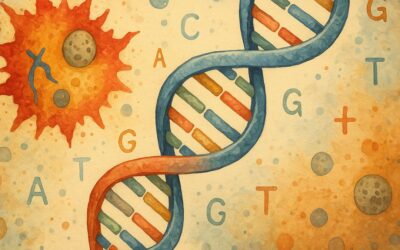The Gist
Bioinformatics: The Intersection of Biology and Computer Science
The explosion of biological data in recent years, particularly with advances in DNA sequencing, has given rise to a new scientific field that sits at the crossroads of biology and computer science: bioinformatics. As the name suggests, bioinformatics is all about using computational tools to manage, analyze, and interpret biological data. From genome mapping to protein structure prediction, bioinformatics has quickly become an essential tool for researchers looking to unlock the secrets of life.
What is Bioinformatics?
At its core, bioinformatics is the application of computer technology to the understanding and organization of biological data. This interdisciplinary field combines the precision of computer science with the depth of biological sciences to solve problems that were previously too complex or time-consuming to tackle by traditional methods. Whether it’s storing vast amounts of genetic information, simulating molecular structures, or predicting the behavior of biological systems, bioinformatics helps make sense of the mountains of data generated by modern biology.
The Role of Bioinformatics in Modern Biology
In the past, biological research involved painstakingly slow processes, from manually mapping genomes to trial-and-error approaches in drug discovery. Today, bioinformatics has streamlined these processes through the use of databases, algorithms, and software that can process and analyze data at lightning speed. One of the most significant applications of bioinformatics is in genomics, where it is used to sequence and map genomes. Projects like the Human Genome Project would have been impossible without bioinformatics, which enabled researchers to assemble, analyze, and interpret vast amounts of DNA data.
Beyond genomics, bioinformatics is also transforming fields like proteomics (the study of proteins), pharmacogenomics (how genes affect a person’s response to drugs), and systems biology, which examines the complex interactions within biological systems. The common thread is that bioinformatics turns biological data into actionable knowledge.
Key Applications of Bioinformatics
1. Genomics and Personalized Medicine
One of the most exciting areas where bioinformatics is making waves is in personalized medicine. By analyzing a person’s genetic information, doctors can tailor treatments to an individual’s specific genetic makeup. This means that diseases like cancer, which often have complex genetic components, can be treated more effectively by considering the unique genetic mutations present in each patient. Bioinformatics is also crucial for predicting how patients will respond to different medications, minimizing adverse reactions and optimizing therapeutic outcomes.
2. Drug Discovery
In the pharmaceutical industry, bioinformatics is speeding up the process of drug discovery. Traditionally, drug development involved years of research and costly clinical trials. However, with bioinformatics, researchers can simulate how a drug interacts with proteins and other molecules in the body, significantly reducing the time it takes to bring new drugs to market. By analyzing vast datasets of biological compounds and their effects, bioinformatics helps identify potential drug candidates more quickly and accurately.
3. Understanding Evolution and Biodiversity
Bioinformatics is also instrumental in studying evolutionary biology and biodiversity. By comparing DNA sequences across different species, bioinformaticians can trace evolutionary relationships and better understand the genetic diversity of organisms. This not only helps in conserving species but also in identifying genetic traits that may be beneficial in agriculture, medicine, and environmental sciences.
The Computational Side of Bioinformatics
Bioinformatics wouldn’t be possible without advancements in computer science. Complex algorithms, machine learning, and artificial intelligence (AI) are at the heart of bioinformatics applications. These computational tools allow researchers to process enormous datasets, such as the billions of base pairs in a genome, in a matter of hours rather than years. Machine learning, for example, is used to predict how different genes will interact, identify patterns in genetic diseases, and even develop models of how diseases like cancer spread through the body.
Additionally, bioinformatics relies heavily on databases to store biological information. Resources like GenBank and the Protein Data Bank contain millions of entries, from genetic sequences to protein structures. Access to this vast array of data allows scientists worldwide to collaborate and build upon each other’s work, driving forward breakthroughs at an unprecedented pace.
Challenges in Bioinformatics
Despite its many successes, bioinformatics faces several challenges. One of the biggest is the sheer volume of data. As sequencing technologies become more advanced and cheaper, the amount of biological data being generated is skyrocketing. Storing, processing, and making sense of this data requires not only powerful computational resources but also advanced algorithms capable of extracting meaningful insights.
Another challenge is the need for standardization. With so many different databases and tools available, researchers sometimes struggle to integrate data from different sources or validate findings across studies. Ensuring that bioinformatics data is accessible, reliable, and interoperable is critical for continued progress in the field.
Bioinformatics is more than just a niche field; it is a vital bridge between biology and computer science that has revolutionized modern science. From personalized medicine to drug discovery, bioinformatics provides the tools necessary to tackle some of the biggest challenges in biology. As technology continues to evolve, so too will the capabilities of bioinformatics, opening up new possibilities for understanding life itself at the most fundamental levels.
The intersection of biology and computer science is where the future of healthcare, agriculture, and environmental science lies. And bioinformatics is paving the way for these transformative changes.
Let’s Talk
So, bioinformatics—pretty fascinating stuff, right? I mean, who would’ve thought biology and computer science would make such a perfect match? But here’s the thing: this field is growing so fast, and it’s not just for researchers in white lab coats. Have you ever thought about how this could impact your life directly? Maybe you’re wondering why it even matters to you, someone who’s not a geneticist or a programmer. Well, let’s dig a little deeper into the practical side of this.
Think about health for a second. You probably have that one friend (or maybe it’s you) who’s gotten a genetic test done, right? Spit in a tube, send it off, and voila! A few weeks later, you get an email telling you about your ancestry, health risks, or even what kind of diet might work best for you. That’s bioinformatics in action, right there in your inbox. It’s not just some abstract science—this is literally helping people make decisions about their health, diet, and even how they exercise. Imagine knowing exactly how your body reacts to certain foods or medications because your genetic makeup was analyzed using bioinformatics tools. Suddenly, eating kale every day doesn’t seem so random!
But let’s take it a step further. What if I told you that bioinformatics could one day make personalized medicine the norm, not the exception? Picture this: instead of a “one-size-fits-all” approach to treating illnesses, you get a treatment plan custom-made for your specific genetic profile. Sounds like science fiction, but it’s happening. There are already drugs on the market tailored to people’s unique DNA, and bioinformatics is behind it. How cool would it be if, in the future, your doctor could look at your genetic data and say, “Hey, this medication will work best for you because of this gene mutation.” That could change the entire game for treating diseases like cancer or even something as common as the flu.
Let’s not forget about the ethical questions, though. How do you feel about all this data being collected? Who gets to own it? Who gets to access it? I don’t know about you, but the idea of someone having a complete map of my DNA is both thrilling and a little bit terrifying. There’s a fine line between innovation and invasion of privacy, and bioinformatics definitely pushes that boundary. Maybe it’s just me, but when we start talking about privacy in the age of data, I can’t help but think of those sci-fi movies where big corporations control everything. Is that a future we’re walking toward with bioinformatics?
And here’s something else that’s mind-blowing: bioinformatics isn’t just about human health. It’s revolutionizing agriculture too. Ever heard of genetically modified crops? Bioinformatics helps researchers understand how to tweak a plant’s DNA to make it more resistant to pests or able to thrive in harsh conditions. Whether you’re for or against GMOs, this kind of technology is becoming more prevalent in how we feed the world. Could it be the answer to food shortages in the future? Will we be eating “super crops” engineered to withstand droughts and still be nutritious? These are big questions, and bioinformatics is right at the heart of them.
On a more personal level, you might not realize how many opportunities this field is opening up. You don’t need a PhD to be part of it. Data scientists, software developers, even graphic designers are getting involved. If you have a knack for tech, you could find yourself contributing to research that saves lives. Imagine telling people at a party, “Yeah, I write code that helps fight cancer.” Now, that’s a conversation starter!
So, what do you think? Could bioinformatics shape the future of how we live, eat, and stay healthy? Or does it all feel like too much technology meddling with nature? Personally, I’m excited by the possibilities, but there’s no denying that with great power comes great responsibility. How we manage this growing wealth of biological data is going to shape our world in ways we can’t even fully imagine yet. What do you think about the intersection of biology and tech?
Let’s Learn Vocabulary in Context
Let’s dive into some of the key words and phrases we came across while talking about bioinformatics. First up is genomics. You might remember how we mentioned that bioinformatics plays a big role in genomics, which is essentially the study of genomes—the complete set of DNA in an organism. In real life, you can think of genomics like a map of your entire genetic makeup. It’s kind of like having the blueprint of a house, but instead of walls and windows, it’s made up of genes. If you ever hear someone talk about “genomic sequencing,” they’re referring to the process of figuring out what that entire blueprint looks like.
Next, we’ve got personalized medicine, which is one of those buzzwords that’s been popping up more and more. It refers to healthcare that’s tailored specifically to an individual’s genetic profile. Imagine you go to the doctor, and instead of just getting the same treatment everyone else with the flu gets, you get a treatment that’s designed for you based on your genetic data. This term is becoming so common, you might hear it in everyday conversations about the future of healthcare. So if you’re talking to a friend about how cool it would be to have medications custom-made for your DNA, congrats—you’re discussing personalized medicine.
Now, let’s talk about algorithms. You hear this word thrown around a lot in tech circles, but in bioinformatics, an algorithm is simply a set of rules or a process used by computers to solve problems—like figuring out how genes interact with each other. When you think about it, we use algorithms in our daily lives all the time, even without realizing it. Every time you search for something on Google, algorithms are what decide which results to show you. In the context of bioinformatics, these algorithms help process huge amounts of data that would take humans years to sift through.
Another fun term is machine learning. We mentioned how bioinformatics uses machine learning to make predictions, like how certain genes might interact or how diseases spread. In simple terms, machine learning is a type of artificial intelligence that allows computers to learn from data and improve their performance over time without being explicitly programmed. It’s like when Netflix recommends a movie you end up loving because it “learns” from the shows you’ve watched before. In bioinformatics, machine learning can help predict things like how likely you are to develop a certain disease based on your genes.
One more cool phrase we used was drug discovery. This is where bioinformatics really flexes its muscles. The idea is that instead of relying on traditional trial-and-error methods that take years, bioinformatics speeds up the process of discovering new drugs by using data. The computers basically “model” how a drug would interact with different proteins in your body, which means fewer experiments in the lab and more potential life-saving medications getting to market faster. Ever been curious about how a new medication makes it to your pharmacy? Well, drug discovery is a big part of that journey.
Now that we’ve unpacked some of these terms, I’m curious: What do you think about the role of technology in healthcare? Do you feel comfortable with the idea of computers analyzing your genetic data to make personalized recommendations, or does that sound a bit too futuristic for you? And what about privacy? With all this data being stored and analyzed, how do we ensure it’s being used responsibly?











0 Comments